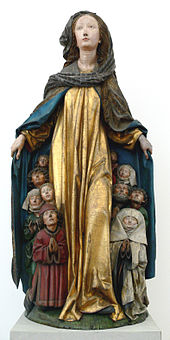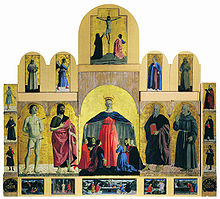Virgin of Mercy
Virgin of Mercy | |
|---|---|
The Virgin of Mercy is a subject in
Usually the Virgin is standing alone, though if angels hold up the cloak, she is free to hold the infant Christ. She is typically about twice the size of the other figures. The people sheltered normally kneel, and are of necessity shown usually at a much smaller scale. These may represent all members of Christian society, with royal crowns, mitres and a papal tiara in the front rows, or represent the local population. The subject was often commissioned by specific groups such as families, confraternities, guilds or convents or abbeys, and then the figures represent these specific groups, as shown by their dress, or by the 15th century individual portraits. Sometimes arrows rain down from above, which the cloak prevents from reaching the people.[1]
Other languages
In Italian it is known as the Madonna della Misericordia (
Pictorial tradition in Christian art

Probably the oldest version known is a small panel by
A miniature of c. 1274 from the Armenian Kingdom of Cilicia also shows a variant of the motif, as do 13th century paintings in Cyprus, such as an icon in the Byzantine Museum in the Archbishop's Palace, Nicosia.[2]
The common factor between all these is the influence and presence of Western mendicant orders, especially the Franciscans, who appear to have been important in spreading this form of iconography.[3]
The immediate inspiration of the iconography comes from a vision reported in the Dialogus Miraculorum of the
This gave rise in the

The image also fits well with the words of the ancient hymn Sub tuum praesidium, probably composed in the 3rd century, and used in most pre-Reformation churches of both the Western and Eastern churches.
Usually the image, whether in sculpture or painting, stands by itself. Nevertheless, in the most famous example, the
The image came in for special derision from Martin Luther, who compared it to "a hen with her chicks".[8]
In the Spanish The Virgin of the Navigators of the 1530s, where those sheltered are a group connected with the Spanish voyages to the New World, including American indigenous peoples, the group is shown over a panorama of ships at rest in a harbour.
In Germany during the Middle Ages, an almost identical image was used featuring Saint Ursula, usually holding her attribute of an arrow to avoid confusion.[9]
In this pictorial tradition, also the iconography of the Works of mercy alludes sometimes to the Virgin of Mercy, such as Caravaggio in his huge painting in Naples, because in 1606/07 it was commissioned for the church of the Confraternita del Pio Monte della Misericordia.[10]
Veneration
The
Our Lady of Mercy is the co-patroness, along with St. Mark, of the Roman Catholic Diocese of Venice in Florida.[11]
Churches dedicated to her include the cathedral of Guasdualito in Venezuela and the National Shrine of La Virgen de las Mercedes, also known as "El Santo Cerro" in La Vega, Dominican Republic.[12]
Other contexts
The term "Virgin of Mercy" is found in a number of other contexts not directly related to the image. It is a common translation of the
The Virgin of Mercy is patron saint of Barcelona, celebrated in the week-long La Mercè festival each year, but in this role is not especially associated with this type of image. The Order of the Blessed Virgin Mary of Mercy, founded, also in Barcelona, in 1218 by Saint Peter Nolasco, has used the image but is not particularly associated with it.
In
See also
- Congregation of the Sisters of Our Lady of Mercy
- Consecration and entrustment to Mary
- Madonna (art)
- Mary Untier of Knots
- Order of the Blessed Virgin Mary of Mercy (Our Lady of Ransom)
- Our Lady
- Eastern Theotokos Pokrova depictions
- Mother of the Church
- Cincture of the Theotokos
Notes
- ^ Hall, 222.
- ISBN 0-88402-202-1. A South German chalice may also be older, see Vasilake, 307, note 17.
- ^ Evans, p. 460.
- ISBN 0-300-10131-7
- ^ Vasilake, 308.
- ISBN 90-04-07809-6
- ^ Vasilake, 307ff; 17th century Ukrainian example
- ^ Hall, 305.
- ^ See the Commons category note for three examples
- ^ Bühren 2017, pp. 67 and 75.
- ^ "Our Diocesan Crest". Diocese of Venice. Retrieved 2019-11-17.
- ^ "Santo Cerro | La Vega, República Dominicana". www.conectate.com.do (in European Spanish). Retrieved 2017-10-30.
References
- Evans, Helen C. (ed.), 2004. Byzantium, Faith and Power (1261–1557), Metropolitan Museum of Art/Yale University Press, ISBN 1588391140.
- Hall, James, 1983. A History of Ideas and Images in Italian Art, John Murray, London, ISBN 0-7195-3971-4.
- Ralf van Bühren, "Caravaggio's 'Seven Works of Mercy' in Naples: The relevance of art history to cultural journalism", in Church, Communication and Culture 2 (2017), pp. 63–87.
- Vasilakē, Maria. Images of the Mother of God: Perceptions of the Theotokos in Byzantium, Ashgate Publishing, 2005, ISBN 0-7546-3603-8.
External links
 Media related to Our Lady of Mercy at Wikimedia Commons
Media related to Our Lady of Mercy at Wikimedia Commons
